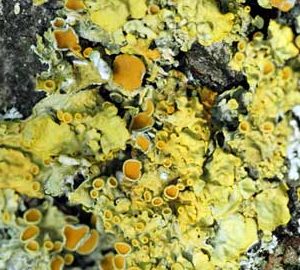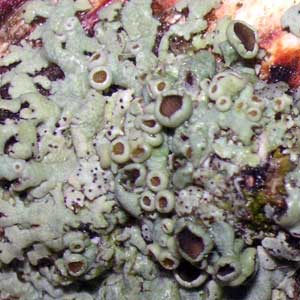Woodlands web update 15.

Lichens losing ?
Sitting on the bark of many trees and on the surfaces of fences and walls, there will be lichens. They are there in summer, winter, spring and autumn. Lichens come in an amazing variety of shapes, sizes and colours. Some can grow in extreme environments such as the rocky summits of mountains. Such lichens grow slowly and may live for hundreds of years.
Lichens are rather unusual in that they are an amalgam of two (or occasionally three) organisms : a fungus and algae. They are symbiotic systems, where the partners of the association work together for mutual benefit. The fungus makes up the bulk of the lichen’s structure (known as the thallus), but the algae (green algae or cyanobacteria) are essential as they can photosynthesise and provide the organism with carbohydrates.


One of the most common algae found in lichens is a species known as Trebouxia. It can exist in association with a fungus to form a lichen, or as a free living organism. If the Earth’s warming continues at the present rate, it may well be too hot for certain species of Trebouxia to survive (in their normal range). Dr M Nelson of the Field Museum (Chicago) has looked at the adaptability of Trebouxia species and suggests that it could take hundreds or thousands of years for Trebouxia species to cope with the temperature changes that we are currently experiencing. These algae may well lose out in the evolutionary race to cope with climate change. This would, in turn, affect many different species of lichen.
Lichens are important in arctic tundra ecosystems, where they together with mosses and liverworts make up the majority of the ground flora. They contribute to food chains, for example, reindeer moss is not a moss but a lichen. Lichens are also pioneer species - they can colonise bare rock and contribute to its weathering (their exudates chemically degrade and physically disrupt the minerals). Lichens may be used by birds as nesting material.

Hedgehogs.
Rural hedgehog populations are still in decline, dropping by 30 to 75%, this is in contrast to urban populations that are ‘steady’. Though urban populations suffer mortalities on the roads, well managed urban areas, parks and wildlife-friendly gardens provide refuges for hedgehogs. The loss of hedgerows and diminishing field margins is contributing to the decline of rural populations.
Land of Plenty report

The WWF-UK has produced a report entitled “Land of Plenty”, which addresses some of the problems that the UK faces now and in the coming decades. There are many reports relating to the loss of plant and animal species and the degradation of particular ecosystems (flower-rich meadows, peatlands, salt marshes etc).
Sadly, much of this damage has been associated with the expansion of our farming / food production systems; indeed some 70% of the land is involved in agriculture. The WWF report outlines how a move towards regenerative farming / agriculture can significantly reduce CO2 and methane emissions, reduce pollution (from fertilisers) and help with biodiversity and resilience. Such changes would (in time) help limit farmers’ exposure to extreme weather events that affect crops / harvests.
One of the many suggestions in the report is the expansion of ‘woodland creation programmes, focussing on potential for broadleaf and native species’. The focus would be on natural regeneration in the first instance, but supported by active tree planting. Full details of the report available in PDF format here.
Drought, bark Beetles and fires.

The Cameron Peak Fire in the Rocky Mountains of Colorado and the Creek Fire in the Sierra Nevada of California burned through forests where large number of the trees had been killed by bark beetles. Warmth favours the bark beetles. Mountain pine beetles had killed millions of lodgepole pines. A dead tree does not take up water, it dries out. The drying out was ‘helped’ by the drought that the West Coast has experienced in recent years. The fires burned with incredible ferocity. In the case of the Creek Fire, the plume reached some 50,000 feet up into the air. The fires were the result of
- Drought / climate change
- Bark beetle infestation
- Large numbers of dead, dry trees
- Consequently, large amounts of energy-rich dry biomass

Full details of the factors behind the forest fires here.
Drought is a major ‘stressor’ affecting many ecosystem across the globe. To understand how drought affects different ecosystems, DroughtNet is working with a number of existing projects and the International Drought Experiment (IDE). A recent experiment at the University of Florida demonstrated how drought-stressed pines did not grow as well, and when faced with an invasive species and fire - they were much likely to succumb than a healthy tree.
Comments are closed for this post.
